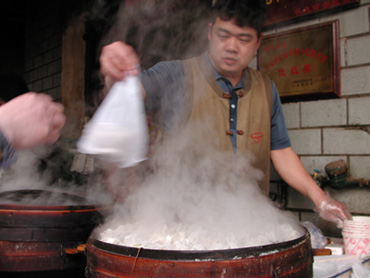South China Morning Post, May 9, 2005
Start your day the Hubu way
By PAUL MOONEY in Wuhan
It's unlikely that there is any place around the world that can match Wuhan when it comes to what most people consider the least important meal of the day--breakfast. The Wuhanese take breakfast so seriously they have even coined their own name for this daily rite, guozao. No one seems to know the origin of this word, but Fang Fang, a well-known writer and long-time resident of the city, says the term, which dates back to the Qing Dynasty, means 'very' in the local dialect.
Because of the variety and low price of guozao, Wuhanese prefer to eat outside, often eating breakfast on the run at one of the ubiquitous food stands or stalls that dot the city. The best place to sample a traditional Wuhan breakfast is in an alleyway tucked away in a corner of Wuchang. As you enter  this narrow lane you will find yourself sandwiched between small eateries on both sides, the 'kitchens' extending right out on to the small street. Steam rises from stacks of bamboo steamers, woks, and huge pots of soup, the cooks appearing and disappearing from behind a curtain of smoke.
this narrow lane you will find yourself sandwiched between small eateries on both sides, the 'kitchens' extending right out on to the small street. Steam rises from stacks of bamboo steamers, woks, and huge pots of soup, the cooks appearing and disappearing from behind a curtain of smoke.
Although some Chinese say it's impolite to eat on the street, local residents walk up and down the alley unabashedly shoveling food into their mouths, many still in their pajamas. Some even bring their own metal bowls along. One guy eats a bowl of wonton while straddling his bicycle. 'No time to sit down,' says another man as he walks by. 'I've got to get to work.'
The most popular dish in Hubu Lane, and possibly all of Wuhan, is hot dry noodles. Fang Fang says that just the thought of this dish can bring Wuhanese to tears when they're far from home. The noodles are cooked first and then are tossed with oil and let to cool for at least one night. When ready to serve, the noodles are quickly poached in boiling water and drained. Then a variety of things can be are added to the noodles: sesame oil, finely chopped garlic, diced radish, vinegar, white pepper, mustard tuber, ginger, scallion and chili. The key ingredient is sesame paste, or tahini sauce. Without this sauce, no respectable Wuhanese would touch the dish.
Another favourite is doupi, a dish said to date back 140 years. Doupi is a thin fried pancake made from the pressed liquid of mung beans and rice. The skin is then filled with minced meat, dried shrimp or dried mushroom, bamboo shoots, and dried beancurd. As a man flips the huge pancake over in his large wok, a small crowd has already gathered to watch him work. 'It's Chinese pizza,' he says without looking up, and the crowd laughs. He slices the 2-1/2 foot circle into small rectangles with a large plate and throws the pieces into a wok behind him, where a fellow worker scoops them into small plastic bowls. In less than a minute, it's sold out, but another batch is already being made. The dish became nationally known after Chairman Mao sampled it in 1958 at Laotongcheng, a famous old Wuhan restaurant.
Mianwo is another local favorite made of glutinous rice, soybean, sesame, ginger and scallion. A special donut-shaped ladle is used, with french fry-shaped pieces of sticky rice placed in the circular part. The ladle is then filled with a batter, and is then dipped into hot oil until it turns a golden crispy brown.
Nearby another small shop is preparing its fresh fish soup. The owner says her family has been in the business for 130 years, although they just moved to this street in 2004 from Hankou. The soup, which is simmering in a huge pot, has a thin milky consistency.
There are also a lot of popular foods from around China. One Nanjing snack is a bread called niuroubing, which a flat piece of dough sprinkled with small pieces of beef and hot peppers and baked Indian style inside a small coal-fired drum. Roujiamo, minced pork served in a tasty bun, is a Shaanxi favorite. There are also stuffed buns from Yangzhou, hand-pulled noodles from Lanzhou, wonton and shaomai from Guangdong. Many of the needles. 'The pine needles gives the food a special flavor,' says a cook who has a mobile phone earphone stuck in one ear.